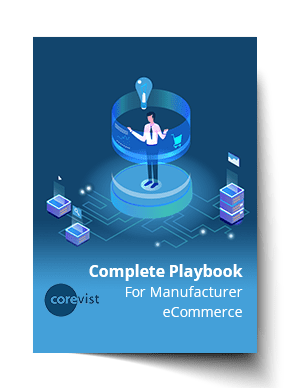Share
Author
George Anderson
Share
Originally published Oct 21, 2021. Refreshed and expanded June 27, 2023.
For manufacturers, B2B ecommerce strategies are as varied as the markets they serve. Every manufacturer’s distribution relationships work differently, and that has a huge impact on which strategies are appropriate at a given organization.
That said, there are several high-level strategies that we see in the manufacturing sector. Regardless of the distribution model that’s already in place, here are some common strategies that manufacturers adopt for ecommerce.
1. Start with self-service order tracking, then upgrade to B2B ecommerce
Some manufacturers aren’t ready to launch B2B ecommerce, even if their customers desperately need it. Maybe they don’t have their product content together—or maybe they can’t figure out what internal processes will look like under a B2B ecommerce model.
Whatever the reason, some manufacturers need a gradual path to B2B ecommerce.
In this case, it’s a great strategy to start with a customer portal for order tracking, then upgrade the solution to add catalog, online ordering, and payments when you’re ready. If you can do it all on the same platform, using the same SAP integration architecture, then you’ve really got a win. (Hint: That’s the thinking behind Corevist Commerce Cloud. You can start with Order Tracking, then upgrade to B2B ecommerce when you’re ready.)
2. Onboard sales reps first, then customers
Sometimes a manufacturer needs to move customers to B2B ecommerce—even if some of those customers are a little stuck in their ways.
How can an organization overcome customer inertia?
Starting with sales reps is a great strategy. If you include your sales organization in the project from the very start, you can turn them into evangelists for B2B ecommerce. In turn, they can introduce customers to the solution and help drive adoption.
Of course, the key is to protect the interests of your reps. Some may see B2B ecommerce as a threat to their livelihood. It’s essential to define an integrated strategy in which your reps work hand-in-glove alongside B2B ecommerce to drive value for customers.
Learn more here: Case Study—Fortune 500 Manufacturer.
3. Moving existing distribution partners to B2B ecommerce
While many B2B ecommerce platform vendors push the B2C-style capabilities of their software, those features aren’t aligned with the biggest opportunity manufacturers have — their existing customers.
B2C-style solutions are designed to attract and retain customers. Yet those capabilities aren’t essential for manufacturers who have contractual relationships with their distribution partners.
If attracting new customers isn’t a priority, then what’s the point of B2B ecommerce?
Actually, B2B portals offer incredible value for manufacturers and their existing customers.
- Manufacturers can reduce their customer service workload by launching self-service portals. The key is deep ERP integration in the portal, so each customer sees accurate contract pricing, inventory, credit status and more. With costs reduced, manufacturers can invest those resources in growth initiatives — or turn them into profit.
- Existing customers get an easier customer experience when they no longer have to call or email customer service to do business. With a B2B portal that’s available 24/7 and always shows their personalized data, they can place, track and pay for orders anywhere, from any device. That’s a lot easier than legacy ordering processes.
4. Launching a new strategic distribution channel through B2B ecommerce
As the world changes, manufacturers often find they need to evolve their distribution strategies. Disruptive technologies, market trends and public health situations can force change overnight. Old distribution partners may go out of business — or if they’re acquired, the relationship may change in a way that’s not advantageous to the manufacturer.
Whatever the scenario, the need for a new distribution strategy is a powerful driver for B2B ecommerce. If you’re defining a new set of dealers or distributors who you’re going to work with, you want to provide a great ecommerce experience for them right away.
5. Selling direct to the end user through ecommerce
This strategy is really a subset of the previous, but it’s worth treating separately.
Sometimes, disruption means eliminating the middleman. For manufacturers, that can take several different forms depending on the product and market.
- Selling direct to a B2B end user (another business)
- Selling direct to the B2C consumer
In both cases, manufacturers should do their research. Bypassing the middleman can have consequences to your market share and your bottom line. Check out this post to explore the caveats and see if this strategy is right for you: Can Manufacturers Sell Direct To The Consumer Without Upsetting Distributors?
6. Getting more value from dealer relationships through a B2B portal
Some manufacturers already have a B2B portal for dealers (or distributors) — but they’re not getting any value from it. When that’s the case, customers usually aren’t getting value from it, either.
How do you know if your portal is failing you and your customers? Look for these telltale signs.
- Customers aren’t using the portal. If they’re still calling and emailing customer service, then something’s wrong. Look at your ERP integration. Can customers see personalized pricing and inventory availability? Does the portal show real-time credit status or empower them to track their orders and invoices with live ERP data? If not, you’ve found your problem.
- Your IT team can’t keep up. If your portal depends on an integration platform sitting between it and the ERP, chances are, your IT team is fed up. This kind of architecture is incredibly difficult to maintain over the long haul as data structures evolve in different systems. Even if you aren’t managing this architecture in-house, it’s almost certainly costing you too much. Corevist clients spend 0.005% – 0.0590% of B2B ecommerce revenues maintaining their solution. You shouldn’t spend more than this if you can help it.
Sometimes you can solve these issues with your existing B2B portal solution. However, if issues stem from a problematic ERP integration, it’s doubtful you’ll be able to fix things with the same architecture. In these cases, a solution that includes ERP integration is a better answer.
7. Launching a global B2B ecommerce program with low-effort spinoff sites
For manufacturers with multiple divisions, geographies or global brands, B2B ecommerce strategy gets more complicated. Each customer segment has unique needs — and the organization may require separate branding or experiences to support these specific markets.
That’s all well and good — but how do you integrate those experiences to the ERP without duplicating your investment? Batch-based ERP integration architecture isn’t cheap to build or maintain.
The key here is a solution with prebuilt ERP integration (like Corevist Commerce). In the case of Corevist, as long as your unique businesses all run on the same instance of SAP ERP (or different instances that are configured the same), you can leverage one instance of our architecture to run numerous spinoff sites. The different portals can have their own look and feel, language and products — but you don’t have to waste resources on duplicate SAP integrations.
8. Improving the B2B ecommerce experience for an acquired product line
We see this ecommerce strategy when a manufacturer acquires a brand or product line. Even if the brand is already sold through a B2B ecommerce channel, the existing solution may not work with the acquiring company’s landscape — particularly when it comes to ERP integration.
In many cases, the ERP integration was broken anyway. When that’s the legacy of the product line, you need to start fresh with a great B2B ecommerce experience.
Even if the product line had a great B2B ecommerce under the previous ownership, it’s rare that the existing ERP integration architecture will work with the new ERP. In these cases, a new B2B ecommerce solution that includes ERP integration is a great way to take the new product line to the next level. This can have a big impact on the ROI that you see from the acquisition, so it’s essential to nail this down.
9. Using ERP migration or consolidation to drive innovation in B2B ecommerce
This situation looks a lot like the previous one. When a business changes ERPs, everything changes.
This transition can be painful, but it usually offers opportunities for growth too.
In particular, if your ERP migration is forcing you to shut off an old B2B portal, you’ve got some important decisions to make. What should a B2B portal look like? What information should it give customers? What should it empower them to do through self-service?
The answers to these questions always come back to ERP integration architecture. Some things simply aren’t possible with a given architecture — or they’re so complex and expensive to build and maintain, they’re just not realistic.
If you’re losing your old ERP-integrated solution, then an ERP migration or consolidation is a great chance to reevaluate your approach to B2B portals and ERP integration architecture. How much was it costing you to maintain that old solution with its integration platform (and the required full-time resources)? If you launched a managed solution that includes ERP integration, how would that affect cost savings — and thus profitability?
These are essential questions to ask as you plan your migration. For more on the topic, see this post: Should We Wait For Our S/4HANA Migration To Launch Corevist Commerce?
NEW Guide:
Your Complete Playbook for Manufacturer Ecommerce
Here are 4 keys to a successful ecommerce channel for manufacturers.










